Carole Terwilliger Meyers's Blog, page 102
January 12, 2011
Sights to See: Wjelbik restaurant, Bautzen (Budysin), Germany
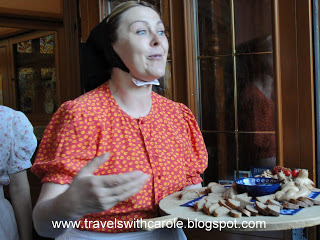 Diners here are greeted traditionally with a large tray of fresh bread and salt, then seated in a cave-like room with and arched stone ceiling. Food is traditional Sorbian fare, perhaps a broth soup with tiny meatballs and egg whites, followed by beef slices with horseradish gravy and boiled potatoes. A phrase in one of the traditional Sorbian songs goes, "We'll never meet as young as we are again, but we might meet as happy as we are again!" Hotel rooms are also available.
Diners here are greeted traditionally with a large tray of fresh bread and salt, then seated in a cave-like room with and arched stone ceiling. Food is traditional Sorbian fare, perhaps a broth soup with tiny meatballs and egg whites, followed by beef slices with horseradish gravy and boiled potatoes. A phrase in one of the traditional Sorbian songs goes, "We'll never meet as young as we are again, but we might meet as happy as we are again!" Hotel rooms are also available. Wjelbik restaurant Kornstr. 7, +49 3591 42060. L-D daily.
view video of Sorbian song:
image and video c2011 Carole Terwilliger Meyers
Published on January 12, 2011 17:19
January 10, 2011
Sights to See: Bautzen (Budysin), Germany
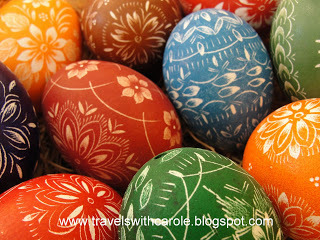 The medieval walled town of Bautzen is situated on the Spree River just 30 miles from Dresden. It has 17 towers and more than 1,000 years of history--it dates to 1002--and is the center of the Sorb minority (formerly the Slavs), which makes up 5% of the town's population. They are mostly Catholic, though a few are Protestants. All signs in Bautzen are bilingual, and the town has Germany´s only bilingual theater--the German-Sorbian People´s Theater. The compact medieval town centre features an ancient city wall as well as many well-preserved churches and towers plus one of the oldest waterworks in central Europe (built in 1558). The Spree River winds through the town and on to Berlin. The Sorbs have kept their traditions, language, and cultural heritage, and it is found nowhere else in the world. Through the years, the area has been claimed by Poland, Germany, Hungary, Prussia, and Austria; in 1635 it became part of Saxony. When Napoleon fought one of his last battles near here, it is said he sat on the town wall and watched. The Sorbs are famous for their hand-painted Easter eggs, and the area is famous for its mustards (68% of German mustard is made here). Also, Eule pipe organs and trams are made here.
The medieval walled town of Bautzen is situated on the Spree River just 30 miles from Dresden. It has 17 towers and more than 1,000 years of history--it dates to 1002--and is the center of the Sorb minority (formerly the Slavs), which makes up 5% of the town's population. They are mostly Catholic, though a few are Protestants. All signs in Bautzen are bilingual, and the town has Germany´s only bilingual theater--the German-Sorbian People´s Theater. The compact medieval town centre features an ancient city wall as well as many well-preserved churches and towers plus one of the oldest waterworks in central Europe (built in 1558). The Spree River winds through the town and on to Berlin. The Sorbs have kept their traditions, language, and cultural heritage, and it is found nowhere else in the world. Through the years, the area has been claimed by Poland, Germany, Hungary, Prussia, and Austria; in 1635 it became part of Saxony. When Napoleon fought one of his last battles near here, it is said he sat on the town wall and watched. The Sorbs are famous for their hand-painted Easter eggs, and the area is famous for its mustards (68% of German mustard is made here). Also, Eule pipe organs and trams are made here.See the town in this video:
image and video c2011 Carole Terwilliger Meyers
Published on January 10, 2011 16:36
January 7, 2011
Sights to See: pilgrimage church and Sorbian cemetery, Ralbitz-Rosenthal, Germany
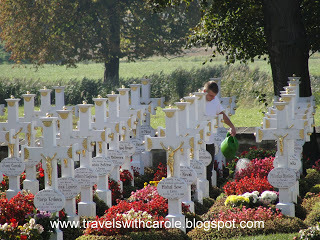 Located in the central settlement area of the Sorbs, this town is a pilgrimage site dedicated to the Blessed Virgin Mary. This pilgrimage church and Sorbian cemetery is administered by the Order of Cistercians. "Welcome to the most democratic cemetery in the world," says Nawka, the village priest. "Before God, we are all equal, and everyone buried here is treated equally. Since before 1840, everyone gets the same crosses." The wood crosses are white, because white is the color of innocence and the color of God, and it was also once the color of mourning for Sorbs (now mourning is black here). After 20 years have passed, the cross is removed and given to relatives and a new person is buried in the spot with a new cross.
Located in the central settlement area of the Sorbs, this town is a pilgrimage site dedicated to the Blessed Virgin Mary. This pilgrimage church and Sorbian cemetery is administered by the Order of Cistercians. "Welcome to the most democratic cemetery in the world," says Nawka, the village priest. "Before God, we are all equal, and everyone buried here is treated equally. Since before 1840, everyone gets the same crosses." The wood crosses are white, because white is the color of innocence and the color of God, and it was also once the color of mourning for Sorbs (now mourning is black here). After 20 years have passed, the cross is removed and given to relatives and a new person is buried in the spot with a new cross. In Ralbitz-Rosenthal.
image c2011 Carole Terwilliger Meyers
Published on January 07, 2011 16:47
January 5, 2011
Sights to See: St. Marienstern Cistercian Convent, Panschwitz-Kuckau, Germany
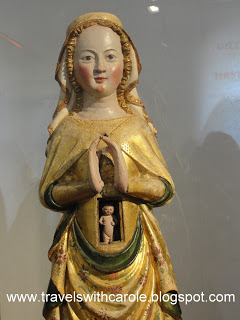 St. Marienstern Cistercian Convent
(means The Star of Mary) Cisinskistrasse 35, Panschwitz-Kuckau, +49 35796 99-30; . E2. Founded in the Middle Ages in 1248 (762 years ago), this catholic refuge is home to an order of sisters that lives according to the rules of the Holy Benedict (only nuns, no monks). The gates are locked at night, and no one is allowed in or out. A self-contained village, it has a lake, gardens, farm land, and a bakery that is its specialty (it had a brewery until the 1960s, when it was delegated to a nearby business). The surrounding area is 98% catholic (though nearby Dresden has more protestants). Since the 1970s, the order's social work has included helping and housing mentally disabled people. Visitors come here to see the nuns and the art in the Treasure Chamber, which beautifully displays its 13th- to 19th-century relics and art, including the famous "Expectant Madonna."
St. Marienstern Cistercian Convent
(means The Star of Mary) Cisinskistrasse 35, Panschwitz-Kuckau, +49 35796 99-30; . E2. Founded in the Middle Ages in 1248 (762 years ago), this catholic refuge is home to an order of sisters that lives according to the rules of the Holy Benedict (only nuns, no monks). The gates are locked at night, and no one is allowed in or out. A self-contained village, it has a lake, gardens, farm land, and a bakery that is its specialty (it had a brewery until the 1960s, when it was delegated to a nearby business). The surrounding area is 98% catholic (though nearby Dresden has more protestants). Since the 1970s, the order's social work has included helping and housing mentally disabled people. Visitors come here to see the nuns and the art in the Treasure Chamber, which beautifully displays its 13th- to 19th-century relics and art, including the famous "Expectant Madonna."image c2011 Carole Terwilliger Meyers
Published on January 05, 2011 16:41
January 3, 2011
Sights to See:Meissen State Porcelain Manufactory and Museum of Meissen Art, Meissen, Germany
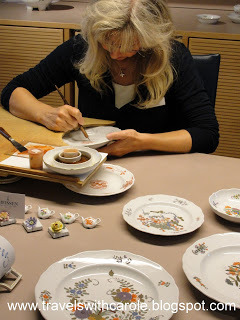 Meissen State Porcelain Manufactory and Museum of Meissen Art Talstrasse 9, +49 (0) 35 21 468-208; . Daily; hrs. vary. 8.50 euros. The first and oldest porcelain manufactory in Europe, Meissen celebrated its 300th anniversary in 2010. It has the oldest trademark in uninterrupted use in the world—crossed blue swords. Guided tours of the visitor center begin with a short film introduction and provide access to an exhibition hall, demonstration workshops, and an outlet store with sky-high prices. The factory itself is only open to the public one day in April and one day in October. Do stop for refreshment in the cafe, where snacks are served on Meissen porcelain.
Meissen State Porcelain Manufactory and Museum of Meissen Art Talstrasse 9, +49 (0) 35 21 468-208; . Daily; hrs. vary. 8.50 euros. The first and oldest porcelain manufactory in Europe, Meissen celebrated its 300th anniversary in 2010. It has the oldest trademark in uninterrupted use in the world—crossed blue swords. Guided tours of the visitor center begin with a short film introduction and provide access to an exhibition hall, demonstration workshops, and an outlet store with sky-high prices. The factory itself is only open to the public one day in April and one day in October. Do stop for refreshment in the cafe, where snacks are served on Meissen porcelain.image c2011 Carole Terwilliger Meyers
Published on January 03, 2011 16:56
December 20, 2010
Sights to See: Porcelain Collection, Dresden, Germany
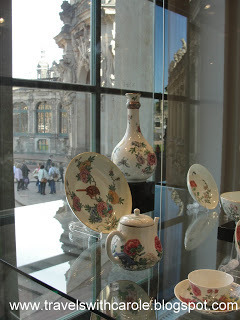 Porcelain Collection, the The Zwinger. This is the largest collection of ceramics in the world. Displays include many fine pieces produced by Dresden's porcelain factories during the 350 years since their founding. An extensive collection of Meissen includes exquisite hand-painted birds, including Jaybirds and Wax Wings, and many displays are set against windows through which you can additionally view the palace grounds outside. Chinese and Japanese pieces are also in the collection. A Glockenspiel above the entrance features a carillon with 40 Meissen porcelain bells that survived the World War II bombing raids.
Porcelain Collection, the The Zwinger. This is the largest collection of ceramics in the world. Displays include many fine pieces produced by Dresden's porcelain factories during the 350 years since their founding. An extensive collection of Meissen includes exquisite hand-painted birds, including Jaybirds and Wax Wings, and many displays are set against windows through which you can additionally view the palace grounds outside. Chinese and Japanese pieces are also in the collection. A Glockenspiel above the entrance features a carillon with 40 Meissen porcelain bells that survived the World War II bombing raids.image c2010 Carole Terwilliger Meyers
Published on December 20, 2010 17:16
December 17, 2010
Sights to See: The Asisi Panometer, Leipzig, Germany
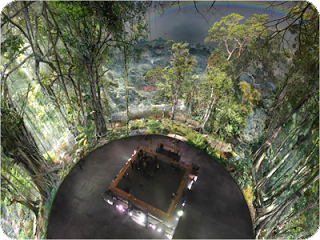
The Asisi Panometer Richard-Lehmann-Strasse 114, +49 (0)341 35 55 34-0. Tu-F 9-7, Sat-Sun 10-8. E10. Created by artist Yadegar Asisi, this innovative 360-degree panorama exhibition is tucked inside a 19th-century cylindrical gas storage building and is the world's largest. The picture measures approximately 88½-feet/27 meters high and more than 328 feet/100 meters long. Previous themes have been "Mt. Everest" and "Ancient Rome." The current "Amazonia" includes colorful scenes in Brazil's rainforest that transform from day through night. When the exhibition ends, one ton of canvas comes down from the walls and is burned. According to Asisi, "It is gone like a theater piece or a concert."
Published on December 17, 2010 15:06
December 14, 2010
Great Sleeps: World's Weirdest Hotels
 Sleep in a sphere or . . .
Sleep in a sphere or . . .http://www.budgettravel.com/bt-dyn/content/article/2010/11/10/AR2010111005589.html?wpisrc=newsletter
Published on December 14, 2010 18:17
December 11, 2010
Things to Do: Christmas markets around the world
Here are some fabulous Christmas markets to dream about visiting.
http://www.frommers.com/slideshow/?group=420
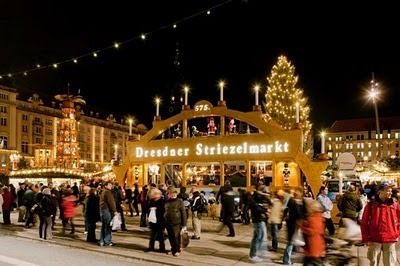
Photo by LH DD Wifö/Wikimedia Commons.
http://www.frommers.com/slideshow/?group=420

Photo by LH DD Wifö/Wikimedia Commons.
Published on December 11, 2010 16:34
December 8, 2010
Things to Do: a holiday greeting from The Fabulous Palm Springs Follies
Next time you're in Palm Springs check out this revue in which all the performers are age 55 and older.
also see
http://caughtontheweb.blogspot.com/search/label/Palm%20Springs
also see
http://caughtontheweb.blogspot.com/search/label/Palm%20Springs
Published on December 08, 2010 18:00
Carole Terwilliger Meyers's Blog
- Carole Terwilliger Meyers's profile
- 1 follower
Carole Terwilliger Meyers isn't a Goodreads Author
(yet),
but they
do have a blog,
so here are some recent posts imported from
their feed.



